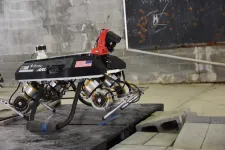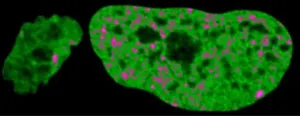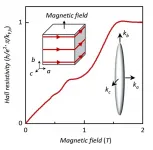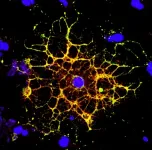(Press-News.org) ABERDEEN PROVING GROUND, Md. - A new formula from Army scientists is leading to new insights on how to build an energy-efficient legged teammate for dismounted warfighters.
In a recent peer-reviewed PLOS One paper, the U.S. Army Combat Capabilities Development Command, known as DEVCOM, Army Research Laboratory's Drs. Alexander Kott, Sean Gart and Jason Pusey offer new insights on building autonomous military robotic legged platforms to operate as efficiently as any other ground mobile systems.
Its use could lead to potentially important changes to Army vehicle development. Scientists said they may not know exactly why legged, wheeled and tracked systems fit the same curve yet, but they are convinced their findings drive further inquiry.
"If vehicle developers find a certain design would require more power than is currently possible given a variety of real-world constraints, the new formula could point to specific needs for improved power transmission and generation, or to rethink the mass and speed requirements of the vehicle," Gart said.
Inspired by a 1980s formula that shows relationships between the mass, speed and power expenditure of animals, the team developed a new formula that applied to a very broad range of legged, wheeled and tracked systems - such as motor vehicles and ground robots.
Although much of the data has been available for 30 years, this team believes they are the first to actually assemble it and study the relationships that emerge from this data. Their findings show that legged systems are as efficient as wheeled and tracked platforms.
"In the world of unmanned combat aerial vehicle and intelligent munitions, there is a growing role for dismounted infantry that can advance, often for multiple days, and attack in the most cluttered terrain such as mountains, dense forests and urban environments," said Kott who serves as the laboratory's chief scientist. "That's because such terrain provides the greatest cover and concealment against the unmanned aerial vehicles. That, in turn, demands that dismounted infantry should be assisted by vehicles capable of moving easily in such a broken terrain. Legged vehicles - possibly autonomous-would be very helpful."
One of the problems with legged robots, Kott said, is they seem to have poor energy efficiency, which limits teaming with Soldiers in austere battlefields.
"For the past 30 years, U.S. military scientists have addressed a number of challenges in developing autonomous vehicles," said Kott. "Ground vehicles that maneuver on wheels or tracks, and air vehicles that resemble small airplanes which we call fixed wing and small helicopters, which are rotary wing, are now quieter and easier to integrate in troop formations. But for legged platforms, many hurdles remain elusive, and a huge one is making them energy efficient."
Soldiers cannot afford to carry fuel or batteries for "energy-thirsty legged robots," he said.
The paper explores whether artificial ground-mobile systems exhibit a consistent trend among mass, power, and speed.
As a starting point, the team investigated a scaling formula proposed in the 1980s for estimating the mechanical power expended by an animal of a given mass to move at a given speed, and compared this to a range of artificial mechanical systems varying in size, weight and power that are autonomous or driven by humans.
The team found the answer to their research question: a similar, consistent relationship does in fact apply also to ground-mobile systems including vehicles of different types over a broad range of their masses.
Kott said this relationship surprisingly turned out to be essentially the same for legged, wheeled and tracked systems. These findings suggest that human-made legged platforms should be as efficient as wheeled and tracked platforms, he said.
To conduct this study, the team collected diverse ground mobile system data from a literature review of previous studies and published data sets.
They studied wide ranges of sizes and morphologies within a data set that combined systems that included for example a 17th century British canon, the Ford Model T, the M1 Abrams tank and an ACELA train.
Gart said their research is relevant to designing ground mobile systems because it helps designers determine tradeoffs among power, speed and mass for future terrestrial robots for defense applications.
One Army goal is to develop new types of autonomous, or partly autonomous, ground vehicle to deliver supplies to Soldiers in challenging terrains, he said.
"To haul supplies, it must be able to carry a certain weight, or mass, at a certain time, or speed," Gart said.
The formula can approximate the amount of power that vehicle will need, researchers said.
"The Army must develop feasible yet ambitious targets for tradeoffs among the power, speed, and mass of future terrestrial robots," Kott said. "It is undesirable to base such targets on current experience, because military hardware is often developed and used for multiple years and even decades; therefore, the specifiers and designers of such hardware must base their targets-competitive yet achievable-on future technological opportunities not necessarily fully understood at the time of design."
The formula developed in this paper gives such a target and could enable the Army to make predictions of future performance of ground platforms such as legged robots given design constraints like vehicle and motor weight and desired speed, he said.
INFORMATION:
As the Army's corporate research laboratory, ARL is operationalizing science to achieve transformational overmatch. Through collaboration across the command's core technical competencies, DEVCOM leads in the discovery, development and delivery of the technology-based capabilities required to make Soldiers more successful at winning the nation's wars and come home safely. DEVCOM Army Research Laboratory is an element of the U.S. Army Combat Capabilities Development Command. DEVCOM is a major subordinate command of the Army Futures Command.
BROOKLYN, New York, Wednesday, June 2, 2021 - Perovskite solar cells have progressed in recent years with rapid increases in power conversion efficiency (from 3% in 2006 to 25.5% today), making them more competitive with silicon-based photovoltaic cells. However, a number of challenges remain before they can become a competitive commercial technology.
Now a team at the END ...
The organization of the human genome relies on physics of different states of matter - such as liquid and solid - a team of scientists has discovered. The findings, which reveal how the physical nature of the genome changes as cells transform to serve specific functions, point to new ways to potentially better understand disease and to create improved therapies for cancer and genetic disorders.
The genome is the library of genetic information essential for life. Each cell contains the entire library, yet it uses only part of this information. Special types of cells, such ...
SMU Office of Research & Tech Transfer - Short selling often gets a bad rap because it is a type of trade that bets against the success of a firm. In essence, short selling allows investors to borrow stock from a broker to sell into the market with the hope of buying the stock back at a cheaper price, thus, profiting on the difference between the sell and buy prices. Because of this practice, short selling is sometimes seen as a controversial tactic.
Furthermore, speculative short selling attacks are concerning as it can put downward pressure on ...
The quantum Hall effect traditionally only plays a role in two-dimensional electron systems. Recently, however, a three-dimensional version of the quantum Hall effect was described in the Dirac semimetal ZrTe5. It has been suggested that this version results from a magnetic field-induced Fermi surface instability that transforms the original three-dimensional electron system into a stack of two-dimensional electron systems. Now scientists at the Max Planck Institute for Chemical Physics of Solids in Dresden, at the Technical University of Dresden, at the Brookhaven National Laboratory in New York, at the Helmholtz Center Dresden-Rossendorf, the Max Planck Institute ...
Boulder, Colo., USA: GSA's dynamic online journal, Geosphere, posts articles online regularly. Locations and topics studied this month include the Moine thrust zone in northwestern Scotland; the Eastern California shear zone; implementation of "OpenTopography"; the finite evolution of "mole tracks"; the southern central Andes; the work of International Ocean Discovery Program (IODP) Expedition 351; and the Fairweather fault, Alaska, USA. You can find these articles at https://geosphere.geoscienceworld.org/content/early/recent.
Detrital-zircon analyses, provenance, and ...
RIVERSIDE, Calif. -- As its name suggests, dark matter -- material which makes up about 85% of the mass in the universe -- emits no light, eluding easy detection. Its properties, too, remain fairly obscure.
Now, a theoretical particle physicist at the University of California, Riverside, and colleagues have published a research paper in the Journal of High Energy Physics that shows how theories positing the existence a new type of force could help explain dark matter's properties.
"We live in an ocean of dark matter, yet we know very little about what it could be," said Flip Tanedo, an assistant professor of physics and astronomy and the paper's senior author. "It is one of the most vexing known unknowns in nature. ...
It's long been known that people living with HIV experience a loss of white matter in their brains. As opposed to "gray matter," which is composed of the cell bodies of neurons, white matter is made up of a fatty substance called myelin that coats neurons, offering protection and helping them transmit signals quickly and efficiently. A reduction in white matter is associated with motor and cognitive impairment.
Earlier work by a team from the University of Pennsylvania and Children's Hospital of Philadelphia (CHOP) found that antiretroviral therapy (ART)--the lifesaving suite ...
There is a long-held belief that having your pet sleep on the bed is a bad idea. Aside from taking up space, noisy scratching, or triggering allergies, the most common assertion averred that your furry companion would disrupt your sleep.
A new study published in the journal Sleep Health tells a different story. Researchers at Concordia's Pediatric Public Health Psychology Lab (PPHP) found that the sleep quality of the surprisingly high number of children who share a bed with their pets is indistinguishable from those who sleep alone.
"Sleeping with your pet does not appear to be disruptive," ...
Do firms respond to tougher competition by searching for completely new technological solutions (exploration), or do they work to defend their position by improving current technologies (exploitation)?
Competition from increased import penetration generally results in tight profit margins, low prices, and strong efficiency pressures, immediately affecting firms' bottom lines in the form of reduced profits and increased bankruptcy risk.
A firm's R&D strategy is one of the fundamental determinants of success or failure when responding to competitive threats. To ensure both short-term performance and long-term survival, firms have two basic R&D options: explore new knowledge or exploit existing knowledge bases. ...
A new study by a team of University of Rochester psychologists and other researchers in the Collaborative Initiative on Fetal Alcohol Spectrum Disorders (CIFASD) finds that partners of mothers-to-be can directly influence a pregnant woman's likelihood of drinking alcohol and feeling depressed, which affects their babies' development.
The study, which appeared in Alcoholism: Clinical & Experimental Research, highlights the importance of engaging partners in intervention and prevention efforts to help pregnant women avoid drinking alcohol. A baby's prenatal alcohol ...






